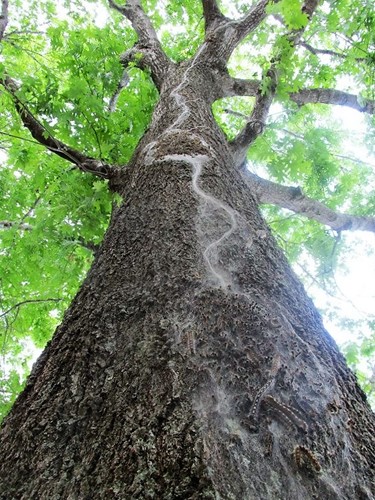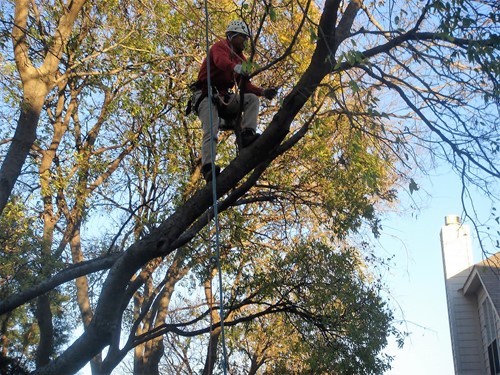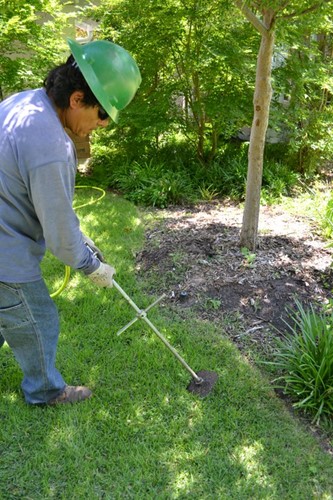

Published December 1, 1998 By KEVIN BASSETT and RUSSELL PETERS
Pathologist's Corner
Another year has gone by and our trees endured another difficult Texas summer. As the new year begins it is a good time to review arboricultural practices which may be needed over the next twelve months.
Insect and Disease Control

Web trails made by forest tent caterpillars. Photo By RuthAnn Jackson.
Many species of trees are targets of pests such as scale insects, lace bugs, phylloxera gall, etc…. Many of these insects may be controlled with a dormant season application of a horticultural grade oil. The oil is applied to smother the insect eggs and/or adults that survived the winter. The material is endorsed in many “organic” insect control programs because horticultural grade oil is easy on the environment and non-target organisms. The horticultural oil application is an extremely safe and effective tool to manage many over-wintering insect pests. Check with your arborist to see if a dormant oil spray would benefit your trees.
Pruning

Martin Ruiz, an expert tree climber at Arborilogical Services pruning one of our client's trees. Photo by RuthAnn Jackson.
Timing of the tree pruning operation may or may not be important to your tree. Most trees may be safely pruned at any time of the year, however, there are exceptions. Due to the incidence of Oak Wilt, it is recommended that Red Oaks and Live Oaks NOT be pruned between February 15th and June 1st. This is because these species are most susceptible due to the increased level of activity of the sap feeding beetle at a time when the fungus is most likely reproducing. Therefore, if your Live Oaks or Red Oaks are in need of pruning, it should be done prior to February 15th or after June 1st.
Control of mistletoe, a parasitic plant, can be achieved by pruning to remove infected twigs and branches. This is not always 100% possible because the mistletoe may have infected major limbs or branches which would not be removed during the normal course of pruning. Control of mistletoe is achieved by removing the mistletoe plant prior to dissemination of the seeds. They are covered with a sticky, gelatinous substance so they will stick to the tree and germinate, thus forming a new mistletoe plant. Birds play a primary role in disseminating the seed. The sticky coating around the seed allows the seed to stick to limbs once it passes through the bird. Pruning for mistletoe control is best done in the dormant season when the mistletoe is easily visible. Normally it will take two or three years for the mistletoe to reach the seed producing stage again. This is when pruning to control the mistletoe should be repeated. There is a chemical spray labeled “for mistletoe control” called “Florel”. Unfortunately, this material is expensive, requires precise timing to be efficient, and can have undesirable effects on non-target plants. If mistletoe is a problem for your trees, consult your Arborist about the treatment options available to control the threat to your trees’ health.
There are a number of fungal leaf diseases which occur on our trees. These would include Black spot of Elm, Ash anthracnose, Oak anthracnose, tar spot, and actinopelte leaf spot. These diseases can be unsightly as well as unhealthy for your trees. They normally begin when moderate temperatures and high moisture levels are present for a long period of time. The droplets of water on the leaf surface create an ideal environment for the fungal spores to germinate, infect the leaf tissue and begin the disease cycle. Severely infected leaves are usually cast off by the tree. A healthy tree will readily produce new leaves, however, this process requires that the tree expend a lot of energy in combating the disease. Weak or otherwise stressed trees may not respond vigorously and decline. These diseases may be controlled. An initial spray with a fungicide treatment is repeated on 2 to 3 week intervals to suppress the fungi until warmer, drier weather prevails and the threat of infection subsides. Trees which have had a disease of this type within the last two years are prime candidates for control measures. This is because the fungal spores over-winter in the bud scales surrounding the new leaf. When the new leaves emerge, the spores are already present. If environmental conditions favor the fungi, infection and subsequent disease symptoms will result
Tree Fertilization and Soil Invigoration

Salvador Martinez, a long term member of the Arborilogical family, fertilizing a client's tree.
Trees normally live in forests. In the forest a trees’ nutrition is supplied by the gradual breakdown of organic matter by micro organisms. The urban forest rarely has this type of nutrient recycling because the urban forest is dominated by large areas of turf and paving. Additionally, we humans have a habit of picking up and discarding fallen limbs, branches, leaves and other sources of organic matter vital to the health and well being of trees. Our tree fertilization/root invigoration program is designed to infuse the urban soil with many of the missing ingredients found in forest soils. Humus is the end product of organic matter decomposition, and is one of the main components of our tank mix for tree fertilization and root invigoration. We add other materials such as sulfur and iron when needed to help our non-native trees adapt and hopefully thrive in what is a less than ideal soil. Our fertilization technique allows for a custom mix of materials required by the species on a given site. For instance, a property which has several Sweet Gum and Magnolia will receive a measured amount of chelated iron and sulfur along with our standard organic mix, in order to provide the tree with nutrients not normally available to them in our high pH, and poorly drained clay soil. Remember, many species planted in Dallas actually prefer a low pH, well drained, loamy or sandy soil and would not grow well in the area without help.
As always, if you have particular questions about your trees, consult with your Arborist. We are confident we can help your trees endure the rigors of growing in our urban forest. We look forward to visiting with you AND your trees.
